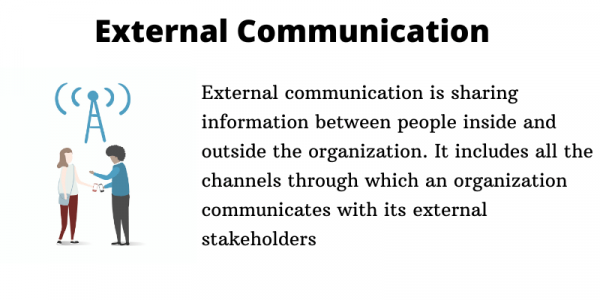Effective external communication is one of the keys to the success of any project or business. The ability to communicate with people outside the organization is as important as communicating within the organization.
External communication is a bit more challenging than communication inside the organization because it involves people unfamiliar with the organization’s culture, values, communications styles, and goals. In this blog post, we will discuss everything you need to know about external communication, including its different types and importance. We will also share tips on how you can be good at it.
What is External Communication?
External communication is sharing information between people inside and outside the organization. It includes all the channels through which an organization communicates with its external stakeholders, such as customers, suppliers, partners, investors, media, and the general public.
Businesses communicate with entities outside the company to boost sales and brand awareness, generate sponsorship, announce events or new products/services, and support branding. Professionals often utilize persuasive techniques in their external communication strategies to create a favorable company image.

Importance of External Communication
Develops community relations
When a company takes the time to reach out and engage with its community, it shows that it cares about more than just making a profit. Community relations are essential to any business, and external communication is the key to developing them.

Through public relations and marketing, businesses can let the community know what they’re doing and why it matters. In addition, by engaging with different organizations, companies can create opportunities for dialogue and collaboration.
Helps share and collect information
External communication helps to share information and ideas and allows organizations to collect feedback from the general public. You can use it to disseminate information about a company or its products, build relationships with customers and suppliers, or resolve disputes.
Builds company’s image and reputation
A company’s image is one of its most important assets. It is the public’s overall impression of a company, and it can influence everything from customer loyalty to investor confidence.
External communication plays the most significant role in shaping public perception. Companies can ensure that their message is communicated loud and clear. Through marketing and advertising, companies can control the message they send to the world.
Helps maintain existing customers and reach more potential customers
External communication is essential for any company that wants to maintain its existing customer base and reach new potential customers. Through thoughtful and strategic external communication, companies can ensure that their message reaches the right people at the right time.
Creates greater transparency and credibility for the company

Businesses can build greater transparency and credibility by keeping the lines of communication open with customers, clients, and other stakeholders. When customers feel like they’re in the loop, they’re more likely to be loyal and continue doing business with the company.
Similarly, when businesses are transparent about their operations and are willing to answer questions, it builds trust and credibility.
Improves crisis management capabilities
In the event of a product recall, scandal, or other crisis, it is crucial to maintain a positive relationship with the public. A company that communicates effectively and efficiently will be able to weather the storm more easily than one that does not. Moreover, effective communication can help to build trust and confidence in the company, both of which are essential in times of crisis.
Common Examples of External Communication
News releases
A news release is a statement issued to the media that announces something new or noteworthy about the company. It might be an event, a product launch, a change in management, or any other major development.
News releases should be well-written and formatted correctly. They should also be concise and to the point, with all the essential information. For example, a news release about a product launch should include the product’s name, features, price, and launch date.
When drafting a news release, the target audience must be kept in mind. The language and tone should be persuasive yet professional. Be sure to proofread and fact-check the release before sending it out.
Social media posts
This kind of external communication can take many forms, such as tweets, Facebook posts, LinkedIn updates, and blog posts.
Social media posts are a great way to share information with customers and other stakeholders in an informal way. They can also help to build relationships with customers and promote brand awareness. However, it’s important to remember that social media is public-facing, so always use caution when posting sensitive information.

When writing social media posts, use eye-catching visuals and catchy headlines to get more shares and engagement. Keep them short and sweet, so they’re easily read on mobile devices. And always make sure the information is accurate before posting it.
Press Conference
Press conferences should be well-organized and well-prepared. The spokesperson should be familiar with the company’s messaging and be able to answer any questions that reporters may ask.
It’s important to remember that press conferences are a public relations tool, so the spokesperson should act professionally and courteously. Press conferences can be a great way to build relationships with the media and generate positive publicity for the company.
Website content and blogging
It includes anything from the company’s About Page to product descriptions and blog posts. Website content should be well-written, accurate, and persuasive. It should also be keyword-rich to ensure that it ranks highly in search engines.
Blogging can be used to announce the news, share product developments, or give insights into the company’s day-to-day operations. When writing a blog post, use a catchy headline and visuals to break up the text. Keep the post concise and to the point, with all the essential information.
Email newsletter
As their name implies, these websites aim to engage their users with news and updates while gently encouraging people to purchase a product or service.
By subscribing to your email list, people agree to receive emails with updates about your product, business, or non-profit. When somebody provides their email address to join your list, they become subscribers and are now considered a lead or contact.
Tips on How to Be Good at External Communication
Know your audience
When communicating with external audiences, it’s essential to remember who your audience is and what they need to know. Remember that different audiences will require different approaches. The goal should be to provide the needed information without overwhelming them.

Be clear and concise
It means being aware of your audience and tailoring your message to meet their needs. It also means being brief and to the point, avoiding unnecessary detail or jargon.
Be responsive
To succeed in external communication, you need to be responsive to the people you’re communicating with. In today’s fast-paced world, people expect quick responses to their inquiries. It includes promptly responding to their emails, phone calls, and text messages—preferably within 24 hours or less.
Use various channels
Don’t rely on just one method of communication— mix it up! Use email, social media, phone calls, and face-to-face meetings to keep your stakeholders updated on what’s going on with your project or organization.
Be consistent
It’s essential to be consistent in the quality and frequency of your communications with stakeholders. Suppose you only communicate when there’s a problem. In that case, people will quickly lose faith in you as a communicator—and they may even start to question your ability to manage projects successfully.

Difference Between Internal and External Communication
Internal communication is typically focused on exchanging information within an organization. It can be carried out among several people on various communication channels. Using internal communications software, you can receive or send an instant message to a coworker about the staff meeting while getting an email from your boss about the new hires beginning next week.
Internal communication is vital for many reasons, one of which is that it reinforces the company’s overarching mission, vision, and values.
External communication, on the other hand, refers to the transfer of information between a business and outside the organization. Although people within the company can still see the message, it is intended for an external audience.
External communication helps you achieve the goals laid out in your marketing plan. It includes various messages like advertising, press releases, social media posts, and your company’s website. You can develop these messages yourself or use a marketing service provider to do it for you.
In a fast-paced and competitive world, communicating internally is not enough. Organizations should know how to do effective external communication to succeed. Reaching the external audience is essential to promote the company’s products, services, and brand.
Remember that not all types of external communication apply to all businesses. Studying the target audience and considering what kind of message will resonate with them is crucial. You should also know your objective so you can choose the most effective platform or channel for communication.
External communication can be a powerful tool to reach new markets and customers when done correctly. It can help promote the company’s brand, increase sales, and can help take your business to the next level.
